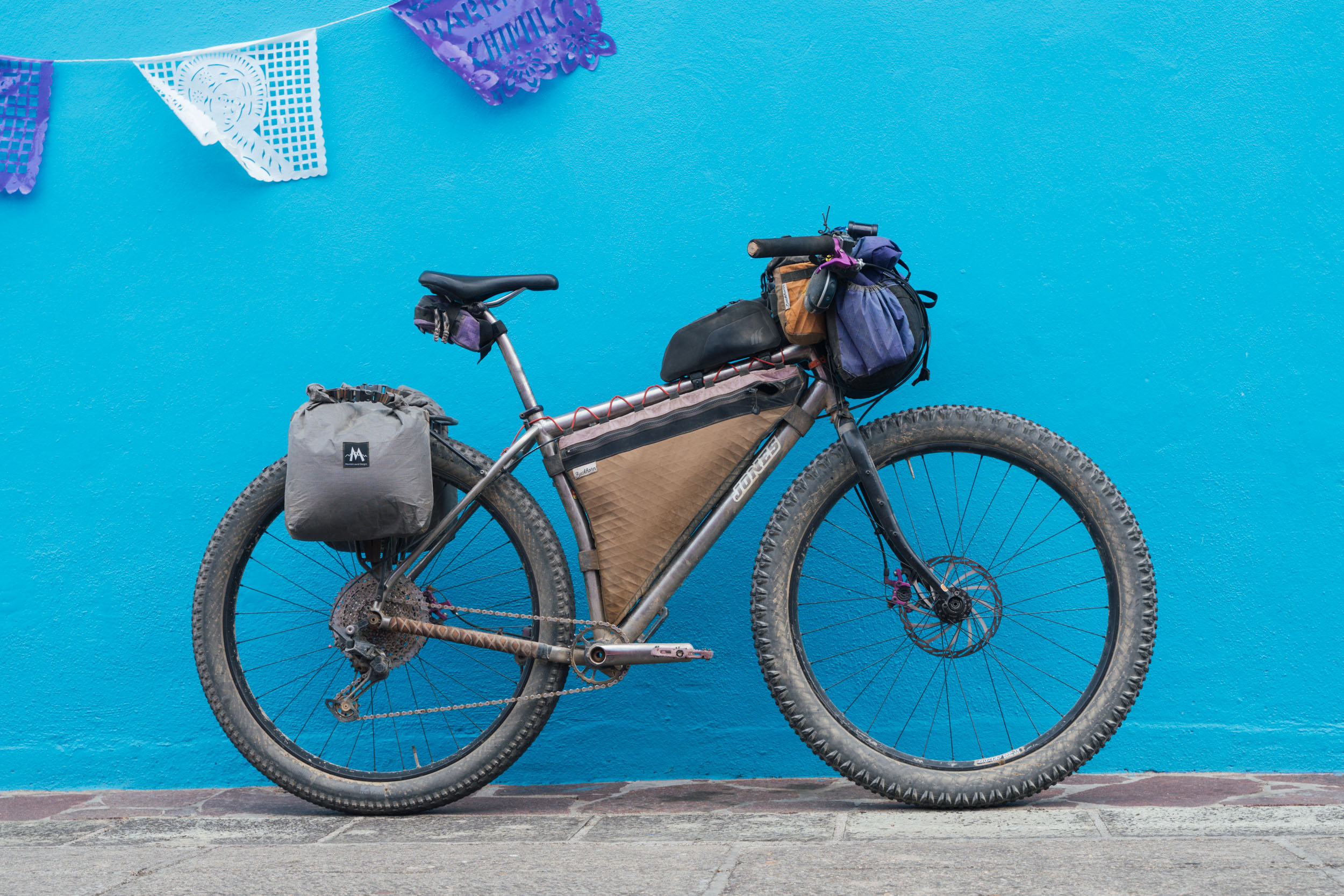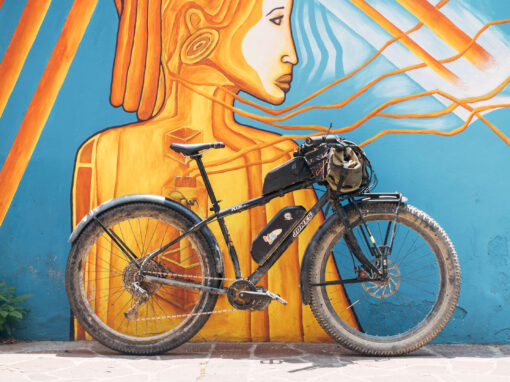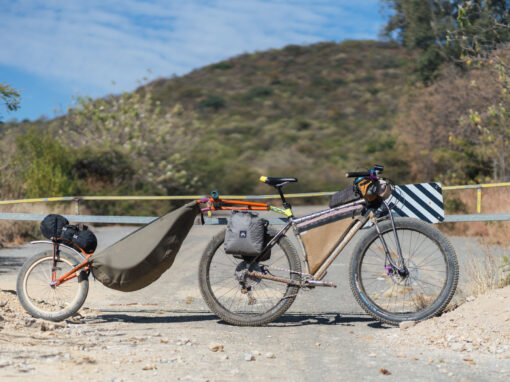These days, it’s easy to get caught up in the excitement of feathery carbon rims and forget that a solid aluminium offering is arguably the better option when it comes to extended bike travels, particularly overseas.
Granted, my own experience with carbon rims, whilst limited, has been mostly very positive. I’ve had my current set for over three years. They’ve proved extremely resilient and especially resistant to big impacts, despite the fact that I often run a relatively low tyre pressure and often ride burly trails. They’re light for their width. And they’ve also held completely true, never knocking even slightly out of shape.
But… when failure does come with carbon, it tends to be catastrophic and impossible to repair. Although alloy rims will dent and slip out of true more easily, dings can often be carefully removed with pliers and a wheel can always be re-trued if need be.
There’s also a very sizeable difference in price, at least when it comes to comparisons between more reputable brands, with carbon rims costing several times that of aluminium ones.
And lastly, there’s the awkward question around the sustainability of carbon components – or rather, the lack of it. I’d like to think that how a product is made, and how it can be recycled at the end of its life, should play a part in the decision-making process for new gear purchases.

29 x 3in tyre at the back, and a monster 3.25in up front for extra comfort and grip.
Anyway, whatever the material, I’m always on the lookout for stout rims for roughstuff touring, and keen to hear real-world feedback from bikepackers I meet. When it came to building up my own wheelset for long-distance travel, I certainly considered going with carbon over alloy, especially as I could likely have sourced an industry discount. But then a little thought niggled at the back of my mind – what if I do have an issue? Whilst many carbon wheel companies now include quibble-free lifetime warranties (which is very welcome, given their initial cost), it’s only useful if you’re somewhere where such a service is easy to access.
Jones Aluminium rims, built up with butted DT spokes, brass nipples, a DT350 rear hub, and a SON 28 dynamo hub.
As for my own needs, my baseline is this: I’m invariably running 2.6in to 3.25in tyres, so I favour rims that have a minimum internal width of 40mm or so, to keep the tyre stable and allow me to run low air pressures for grip and comfort without the tyre rolling.
In the past, I’ve chosen Surly Rabbit Holes and WTB i45s. Surly Rabbit Holes have been fantastic but they’re not the easiest to set up tubeless, nor are they currently available. As for my trusty WTBs, I’ve recently been hearing reports of cracked KOM Toughs amongst long-distance bikepackers, particularly around the spokes.
This is a turn of events that I’m very much hoping Jones’ 50mm Aluminium Rims (45mm internally) will avoid, as the spoke beds are eyeletted, which is a rare thing these days. Eyelets can help to dissipate stress and often reduce the chance of a rim cracking.
Not only this, but these Jones aluminium rims are also available in a choice of 36 or 32-hole drillings. I stuck with 32H but 36H could be a good choice for heavier riders, and e-bike applications too. You can choose between 27.5 and 29in wheel diameters, so a lot of bases are covered.

I don’t know of any other wide rim with eyelets! Mine are drilled for Shraeder, but right now I’m running Presta valves without any issues until I get some Shraeder tubeless valves.
In fact, when I first started long-distance touring, I wouldn’t have considered a rim that didn’t have 36 holes or wasn’t eyeletted. But I guess they both fell out of favour, perhaps due partly to their added weight. Indeed, the downside to these rims is that at 755g, they weigh more than the equivalents from other brands like WTB, Race Face, and Velocity.
Still, I think it’s a price that’s probably worth paying on a bikepacking bike intended for extended travels, overseas and otherwise. After all, if an alloy rim is going to fail through wear and tear, or even overtightening, it’s likely it will be around the spoke head. And whilst you can sometimes ride a fair way on a cracked rim, eventually it’s going to need replacing. This can be a logistical pain, especially with a plus-tyre wheelset, as they’re increasingly hard to find outside the US. Sure, you could get a new rim couriered out to you, but unless you have the skills, you’ll need to find a good wheelbuilder to lace up your wheel from scratch, too.
Given that I’m often pulling Huesos in the trailer, I rarely travel especially light these days, so value a stout wheelset.
Jones’ 50mm alloy rims appealed as they’re reassuringly double-walled, and they’re available in Presta or Shraeder drilling. Shraeder actually makes good sense for a wide rim where they’re plenty of metal real estate – they’re easier to set up tubeless, as you can get more airflow to help seat the bead of the tyre, and there are auto shops the world over with compressors. Schrader valves are really stout too, whereas Prestas cores can easily bend. A downside for me is that my favourite pump – One Up’s EDC – is Presta only though. Darn!
Schrader valves are easier to set up tubeless than Presta, and tend to be more robust.
Price-wise, these Jones alloy 50mm rims come in at $88 each, which is actually really reasonable. And compared to their own carbon offering, they’re a real bargain. Granted, Jones $660 C-rims measure a super wide 56mm external/49mm internal and weigh a scant 560g. But still, it’s a lot of $$$ (interestingly, C-Rims are also available in 32H and 36H drilling, and Presta or Shraeder, which is pretty cool too).
Otherwise, it’s becoming slim pickings on wide rims. I’d consider WTB’s e-bike offerings – like the WTB HTZ i40 rim, which tips the scales at a comparable weight (778g) – but they’re over $125 per rim and I’ve yet to hear any long-term feedback about them. Tumbleweed has a 40mm alloy rim too but from what I can see, it’s only available as part of a bike build.
SON 28 dynamo hub. This one is the 150TA version, for a Jones fork, which is eye-wateringly expensive.
Hubs-wise, I went for a SON 28 dynamo and a DT 350, both of which I already owned. The SON 28 is a costly dynamo hub but it works really well with my Sinewave Beacon, which I use for both light and charging. You can read my Beacon review over on Bikepacking.com.
And I love how easy DT350s are to clean and grease, coupled with the fact that you can remove the cassette without any tools if you break a spoke. The pickup may not be as quick as other high-end offerings, but they seem to have everything else beat on reliability – I’ve actually never heard of one failing, partly because they’re so simple that there’s almost nothing that can go wrong. Short of going with an internal hub like a Rohloff, I think they’re the best choice for long-distance bikepacking, the only downside to me being their whirring noise. Adding some of their special ratchet grease – aka Special Grease! – helps.
I love DT 350 hubs. They’re so easy to clean and service, largely tool free.
As to the rest of the build, I went with DT butted spokes and a standard 3 cross lacing, and chose brass nipples rather than aluminium ones. There’s a small weight penalty to brass, but with a tubeless setup especially, a cracked or rounded-out spoke nipple is a real pain to deal with. Many high-end wheelsets try to sneak in aluminium spoke nipples to save some weight but I don’t think it’s worth it for bikepacking.

What else? I’ve been running this wheelset for a number of months now, in all kinds of conditions and hauling different payloads, and so far so good.
They’ve seated most tubeless tyres easily, with either a standard floor pump – or my Specialized Blast for more stubborn or fresh-out-the-box tyres. I’m not sure if they’re better than other rims in this department, but don’t seem to be any worse.
In terms of tyre widths, they work well with tyres that range from 2.6 to 3.25 inches – wider being better – given their internal diameter of 45mm.
Of course, the fact that they haven’t knocked out of true or cracked thus far doesn’t mean it won’t happen eventually. But having run a 36-hole set on the much heavier Jones LWB HD/e without issues, both non-assisted and electric (with all the associated torque that a motor inflicts), I’m confident they’re built tough.

As mentioned, alloy doesn’t tend to be as impact resistant as carbon and over the months, I’ve had a couple of very minor dings but nothing that has affected the integrity of the tubeless setup. They’re also a good deal heavier than my carbon rims, so the bike isn’t quite as peppy when accelerating. But on a big trip, with a loaded setup, it’s not really an issue.
Hauling extra gear for a tour with Sage on the LWB HD/e, with comes stock with the same rims (but different hubs). I’ve put about 2500km on these rims, a good proportion of which have been in e-bike form.

Huesos approved!
Also worth noting is that these alloy rims are only available in a symmetrical drilling pattern, compared to the Jones C-Rims, for instance, which are both offset and symmetrical, and will ultimately build into stronger wheels.
I’ll report back if anything does eventually go awry. But right now, I feel confident that this touring wheelset would work well for heavily laden bikepackers who err towards rough stuff routes. And as mentioned, the price is hard to beat too. Recycling qualms aside, would I recommend a reputable carbon rim for an extended bikepacking trip, if you can afford it? Whilst I can certainly see the temptation, there’s still a valid reason for sticking to metal, IMO. How about for unladen trail riding though? I can’t deny that those 400g+ of rotational weight would definitely make a difference…
Either way, please share your thoughts and experiences, especially when it comes to wide rims suitable for plus-sized tyres, and big trips where you’ve really put your wheels through the wringer.
Thanks for reading!
May 2023 update: I’ve now fitted these rims with Schraeder valves and the tyres went up easily with a floor pump, once the core was removed. When I was using Presta valves, I needed to deploy my Specialized Blast to get the tyre to seat. So a definite improvement there.


























Gary L.
31 October 2023 at 6:39 pm
Man, I would have kept my Ti Diamond LWB if I could have found a unicrown fork for it at the time. LWB unicrown forks are so much more forgiving than the Jones Truss Fork. Since then, I was able to purchase a LWB fork with a paint blem from Jones Bikes for a new steel LWB frame. But we’re still looking to next year for the first quality LWB unicrowns to be available on the Jones website again. What was your reasoning for running a unicrown fork on the bike you have featured in the article, Cass? The Anything Cage mounts? Or some other reason?
I’ve enjoyed your blogs for a long time, from when we both owned Surly Ogres, and now your in-depth discussion of interest to Jones owners.
Cass
1 November 2023 at 7:19 pm
Thanks for your message, Gary!
Cost aside, I’m mostly into the unicrown for practical reasons. It’s easy to fit different front racks (like the OMM Divide and the Tubus Duo), as well as cargo cages and mudguards. It’s also really quick and easy to remove for travel. And, it makes the bike stand out a bit less, which is sometimes useful.
That said… I now realise that my LWB (size M) fits inside a Ground Effect Tardis bike bag, without removing the truss fork (or even turning it inwards), which is fantastic! I use the Tardis on flights and trains that don’t accept roll-on bikes – like a lot of the TGVs in France.
Although I did notice a difference in ride smoothness between the two fork styles, now that I’m almost exclusively running 29 x 3.25s Crux Duros, generally at low pressures (say, 10 psi or less) I’m really happy with the way the truss fork feels – in terms of balance precision and comfort. Plus, I have some neat 3D printed ‘truss struts’ that Tailfin made for me, so I can now run their panniers off the truss fork directly. This means that not only is the ti truss ultra light in the first place, but there’s almost no additional hardware either! After messing around with luggage configurations, I’ve decided I prefer the way the LWB feels front-loaded, at least with heavier loads, as there’s less risk of any steering ‘waggle’!
Ryan
15 February 2024 at 7:38 pm
Thank you for the review Cass! I always appreciate your insights. I’ve got a call scheduled for next week with Jeff about a similar set! Definitely going with a SON hub up front. Not sure I need to have a rear wheel built but I’m thinking about it. Trying to weigh the reliability with the stock Jones hub vs the DT 350.
I’m sticking with the aluminum mostly for budget reasons but I’d love to ride some of those C-Rims!
I was also curious if you stuck with the 60mm stem on your SWB build? I’m running the stock 90mm (large SWB) and even though reach is short, I feel maybe the Jones setup should be slightly shorter to be just right! I have a bit of lean and weight on my hands at the closest reach.
Cass
16 February 2024 at 9:32 pm
Hi Ryan,
I’m a big fan of the DT 350 hub! I reckon it’s about as reliable as they come, you can service it without any specialist tools, and run it with all manner of drivers, be they SRAM or Shimano. I don’t know anyone who has ever had an issue with that hub, and I’m always asking! The engagement isn’t as quick as some other high-end hubs, which puts some people off.
The C-Rims are noticeably lighter and super fun on trails, but I’m still a big fan of aluminium for touring wheels. I’m running this wheelset on my Spaceframe, for mountain biking, city riding, and bikepacking, and it’s proved super solid so far. I think they’re a great option for the price.
I no longer have that SWB frame – but for me, stem length depends on the size of the frame. I can fit both Medium and Large Jones frames, so tend towards a 50/60mm stem on an L, and about 70mm on an M.
Cheers!
Ryan
17 February 2024 at 4:37 pm
I think I’m sold! I I was just going to do the SON front but I guess it will be worth using the stock set for my winter studded tires. Always nice to have an extra set since the SWB is my only bike!
I guess I’ll try to go a bit shorter on the stem, still adjusting to the Jones fit. We are the same height with almost the same inseam so I wanted your opinion!
Thank you and stay safe with those fires in the area!
Cass
20 February 2024 at 5:41 pm
Ah yes, if we’re similar heights/inseams and you’re on an L, I’d definitely experiment with a shorter stem!